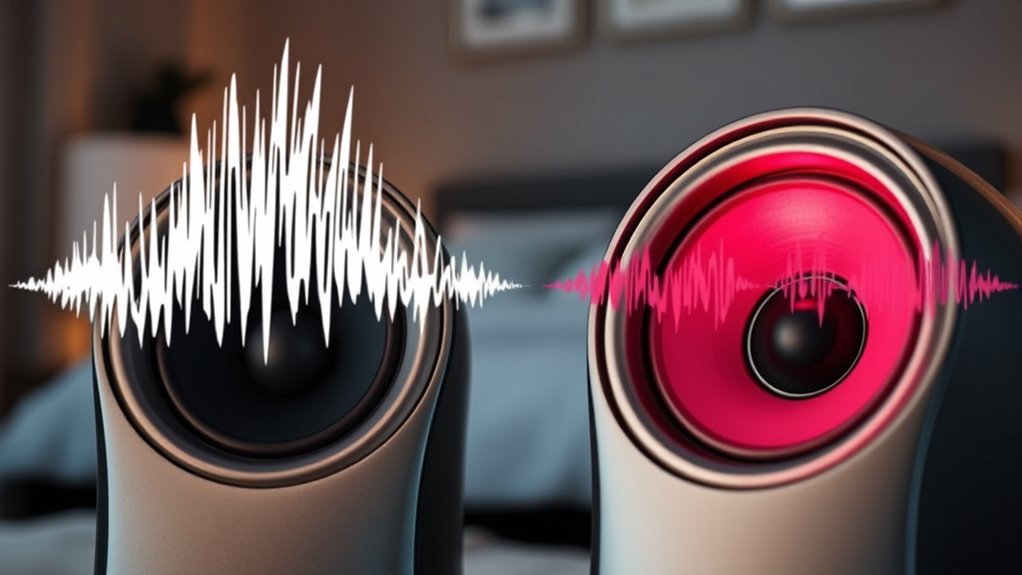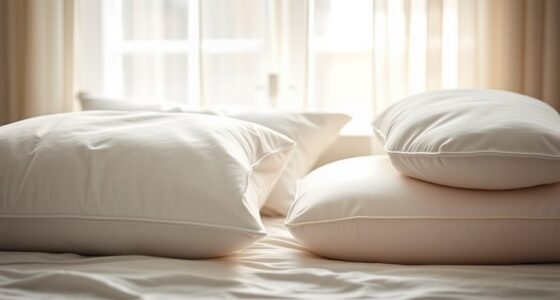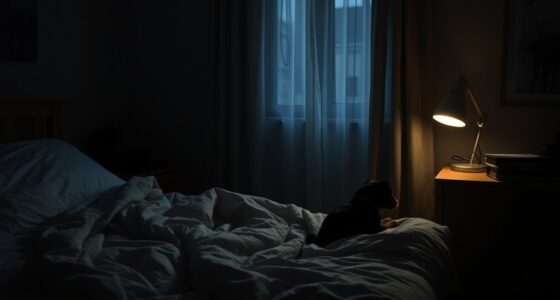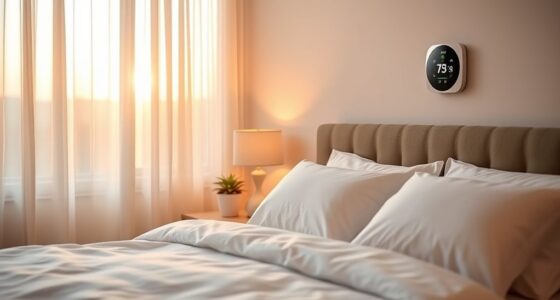If you want to fall asleep faster, pink noise might be your best bet because its softer, more natural sound mimics environmental noises like rain, helping you relax and stay asleep longer. White noise creates a consistent, static-like sound that can also be effective, especially if you prefer a sharper, more uniform tone, but it may sometimes feel harsh or intrusive. Keep exploring to find out which type suits you best and how to optimize your sleep environment.
Key Takeaways
- Pink noise’s natural, softer sound may promote faster sleep onset and deeper, more stable sleep cycles.
- White noise’s consistent, high-frequency sounds can help some individuals fall asleep quicker by masking sudden noises.
- Personal preference and sensitivity to high frequencies influence whether white or pink noise lulls you faster.
- Pink noise’s resemblance to environmental sounds like rain can create a more relaxing, sleep-inducing atmosphere.
- Experimenting with both sounds and volume levels helps determine which type more effectively helps you fall asleep faster.
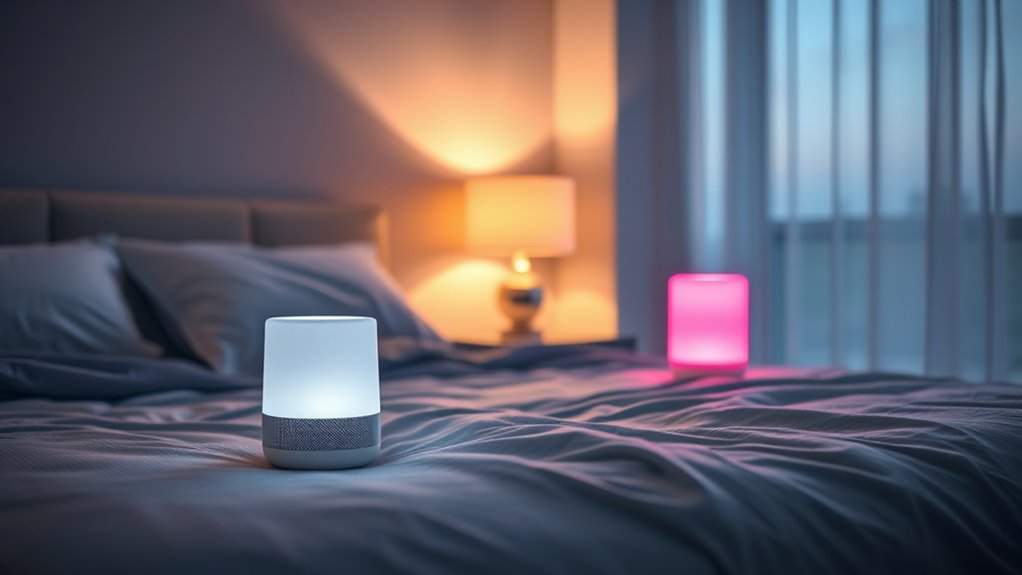
When choosing between white noise and pink noise, understanding their differences can help you find the right sound environment for relaxation, focus, or sleep. Both sounds are used to mask distracting noises, but they differ in how their sound frequency is distributed, which impacts their effectiveness and your experience. White noise contains all audible frequencies played at equal intensity, creating a static-like sound that’s consistent and uniform. Pink noise, on the other hand, emphasizes lower frequencies more than higher ones, resulting in a deeper, more balanced sound. This difference influences how each sound interacts with your brain and body, especially when it comes to sleep quality.
Understanding the differences between white and pink noise helps optimize relaxation and sleep environments.
White noise’s equal sound frequency distribution can be very effective at blocking out sudden, sharp sounds like traffic or voices. Because it’s constant and unchanging, it creates a masking effect that can help your brain tune out external distractions. However, its high-frequency components can sometimes feel harsh or unnatural, which might make it less relaxing for some people over extended periods. Pink noise’s focus on lower frequencies tends to produce a softer, more soothing sound that many find less jarring. Its natural, gentle hum can resemble the ambient sounds of nature, making it easier for your mind to relax and drift into sleep.
When considering sleep quality, pink noise often has an edge because its sound frequency distribution more closely mimics the sounds found in natural environments, like rustling leaves or steady rainfall. This familiarity can facilitate quicker transition into sleep and more stable sleep cycles. Many studies suggest that pink noise can promote deeper sleep and reduce awakenings during the night. White noise, while effective at initially drowning out interruptions, may sometimes cause lighter sleep or awakenings if the high-frequency sounds become bothersome or too intense for your personal preference.
Your personal response is key. Some people find white noise’s sharp, consistent sound helps them fall asleep faster, especially if they’re used to a more uniform auditory environment. Others prefer pink noise’s softer, more natural tone, which can be less fatiguing over long periods. It’s worth experimenting with both to see which sound better supports your sleep quality and overall relaxation. Keep in mind that volume also matters: too loud, regardless of the type, can disturb your sleep, so set your sound level to a comfortable, unobtrusive level. Ultimately, knowing the differences in sound frequency helps you choose the sound that best calms your mind and enhances your sleep experience.
Frequently Asked Questions
Which Noise Type Is Better for ADHD Focus?
When choosing noise for ADHD focus, consider noise therapy and sensory stimulation. Pink noise often provides a smoother, more natural sound that can improve concentration without overwhelming your senses. White noise offers a consistent background, but pink noise’s softer tones might be better for sustained focus. You should experiment to see which type helps you stay attentive longer, as personalized sensory stimulation is key to effective noise therapy.
Can White or Pink Noise Cause Hearing Damage?
Did you know prolonged exposure to loud noise can damage hearing? Both white and pink noise, if played at high volumes, can harm your hearing safety. Noise exposure over 85 decibels risks permanent damage, so keep volume levels moderate. Always monitor the sound level to protect your ears, and take breaks to prevent hearing loss. Your hearing health depends on mindful listening habits, regardless of noise type.
Are There Health Benefits to Pink Noise?
Pink noise offers health benefits, especially for improving sleep quality. It can help with brainwave entrainment, promoting deeper relaxation and more restorative sleep. By reducing stress and enhancing focus, pink noise supports overall mental well-being. You might notice better sleep patterns and increased calmness when you incorporate pink noise into your routine, making it a helpful tool for promoting healthier sleep and mental clarity.
How Do I Choose the Best Noise for Sleep?
When choosing the best noise for sleep, consider your sleep environment and sound customization preferences. You want a sound that masks disruptive noises without being intrusive. Try different options like white noise, pink noise, or nature sounds to see which helps you relax best. Personal preference matters, so experiment with volume and type until you find the ideal background noise that creates a calming atmosphere for restful sleep.
Does Noise Type Affect Dream Intensity?
The type of noise you choose can influence your dream intensity, affecting your sleep quality and mental relaxation. White noise might create a consistent soundscape that promotes deeper, uninterrupted sleep, potentially dulling dream vividness. Pink noise, with its softer, more balanced sound, can enhance relaxation, leading to more restful dreams. Experimenting with different noise types helps you find what best supports your sleep and mental calmness.
Conclusion
Ultimately, choosing between white noise and pink noise depends on what soothes you best. While white noise can be a quick fix for some, pink noise offers a gentler, more natural soundscape for others. Don’t put all your eggs in one basket—try both and see which helps you drift off faster. After all, the proof is in the pudding, and only you can find the lullaby that truly hits the spot.
